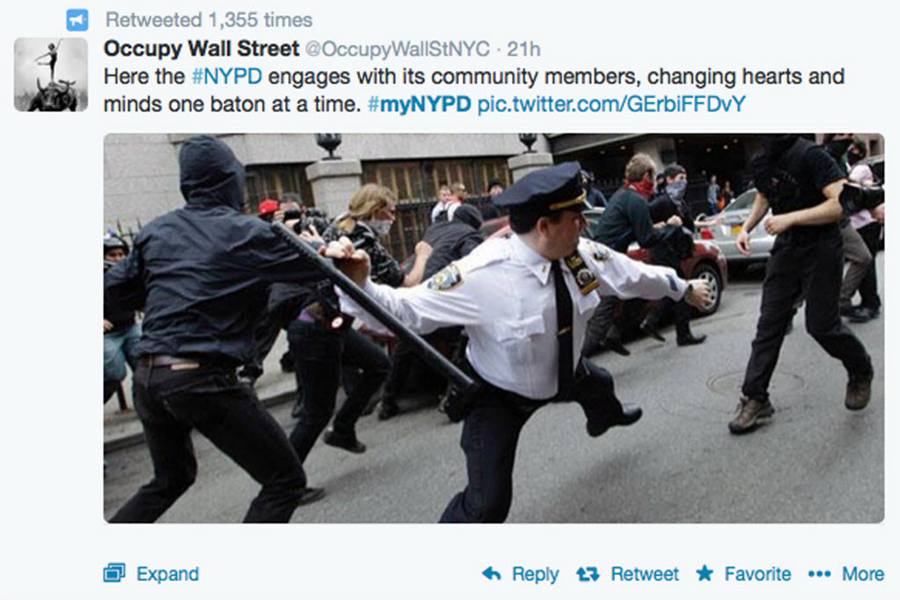NYPD community-building in the Twitterverse? Why it was a #epicfail.
Loading...
| New York
@NYPDnews, the official Twitter handle for the New York Police Department, got a lesson yesterday on the meaning of #epicfail.
That’s online slang for a complete and utter failure for something that shouldn’t be so hard.
It began innocuously enough. @NYPDnews sent out a chirpy public relations message Tuesday, asking its social media fans to tweet some feel-good photos of the department’s finest working city streets.
“Do you have a photo w/ a member of the NYPD? Tweet us & tag it #myNYPD. It may be featured on our Facebook.”
It’s a tactic called “crowdsourcing” in the online world: a person or organization pings the rough-and-ready hordes on social media, asking them for information or ideas – or friendly content to share.
Police Commissioner Bill Bratton and Mayor Bill de Blasio have made a priority of improving relations with New York communities since taking over, following a year of bitterness and rancor in well-publicized disputes over stop-and-frisk, the controversial street tactic that a federal judge found unconstitutional.
But after their friendly PR ping, the Twitterverse exploded with responses, and by early Wednesday, more than 70,000 wags weighed in with a torrent of sarcasm and anger, making #myNYPD the top-trending hashtag on Twitter, replacing #HappyEarthDay.
“The #NYPD will also help you de-tangle your hair,” tweeted @MoreAndAgain, posting a picture of a woman led away with her hands cuffed behind her, with a cop yanking back her hair.
“Here the #NYPD engages with its community members, changing hearts and minds one baton at a time,” taunted @OccupyWallStreetNYC, showing a shot of an officer about to strike a protester with his service baton.
“You might not have known this, but the NYPD can help you with that kink in your neck,” quipped @MoreAndAgain, tweeting a picture of a shirtless man with an officer’s knee on his neck.
These photos had no context, of course, and crowdsourcing like this is never the more fair and accurate way to gather information. And there were more than a handful of smiling cops with locals and tourists and such, but hardly what the NYPD had in mind.
"The NYPD is creating new ways to communicate effectively with the community,” the department said in a statement, as the trend continued to rage Wednesday. “Twitter provides an open forum for an uncensored exchange and this is an open dialogue good for our city."
And now the hashtag has spread to other big city departments. On Wednesday, copycat tags like #myLAPD and #myCPD have begun to display pictures of brutal scenes of police aggressiveness in Chicago and LA as well.
“This is just part of a long line of Twitter fails,” says Aram Sinnreich, a social media expert at Rutgers University School of Communication and Information in New Brunswick, N.J. “These continue to happen when organizations try to use a social network for their public relations efforts without putting much effort into it.”
Last fall, after JPMorgan Chase helped take Twitter public, they used the social media site to crowdsource a friendly Q&A in which an executive would give career advice to young aspiring bankers. For a company fined about $20 billion for financial shenanigans the last two years, let’s say it didn’t go so well.
Home improvement giant Home Depot last fall also tweeted a chirpy PR photo during its sponsorship of college football. It depicted three men drumming on Home Depot 5-gallon plastic paint cans: one, who wore a gorilla suit, was flanked by two black men. “Which drummer is not like the others?”
The result? #epicfail, to say the least.
“The funny thing about it is that, whoever is advising, these organizations never seem to learn,” says Professor Sinnreich. “What’s happened over and over again is that these inorganic, inauthentic efforts to create viral social memes in the form of hashtags have backfired.”
“But then they have been used by the broader population to speak truth to power,” he says.






